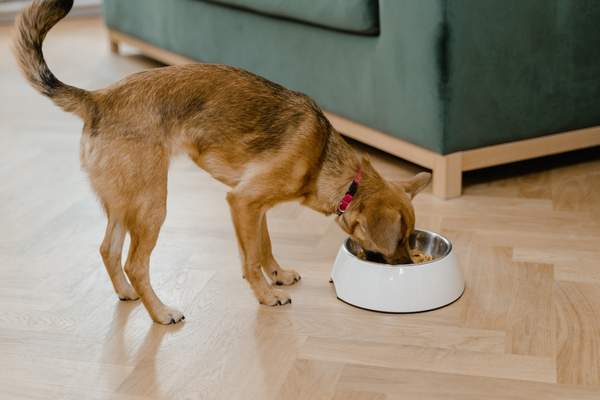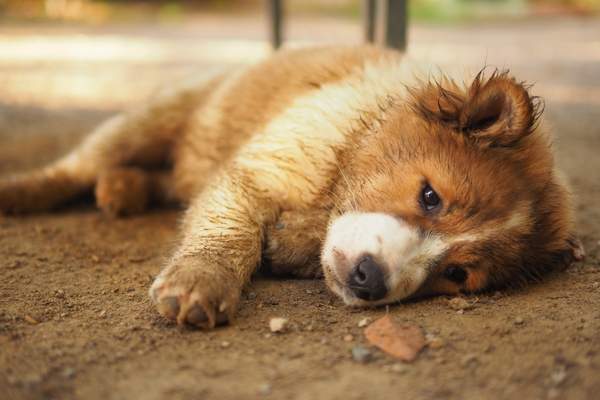Eating is a necessity to all living beings to survive and frequency of eating is always a concern. Whether it’s eating at all hours of the day or only one, when your pet has lessened their appetite, you’re right to be concerned.
So, why does my dog only eat once a day? There’s multiple reasons your dog is only eating once a day. The most likely reason, however, is it can either be from some unknown, or known, medical issue, they don’t like the food they’re eating, they’ve adapted to this new routine, or it could even be stress.
We’ll go over all of these issues in detail and where these problems arise so you can prevent them in the future. But most importantly, remember that your local vet will know much more about the medical history of your dog and their own habits than we will. You should always seek out a professional for a problem causing your dog harm.
Is This Normal Behavior?

To put it frankly: no, it isn’t. Any living being that only eats once a day, unless they’re a smaller animal that eats in large amounts, is not living a healthy lifestyle. Ask any veterinarian and they’ll tell you that the recommended amount of meals is at least two for an adult dog.
For puppies or even older dogs, it varies. But no matter the age, your dog shouldn’t only be eating once a day. It’s impossible to get all their required nutrients each day from one meal. Especially for puppies, they need lots of nutrients and calcium to develop normally.
This doesn’t mean that your dog is in imminent danger and you should panic. It could be a quick fix and as simple as changing your dog’s food or routine. At the same time, you also shouldn’t take this lightly; appetite is one of those signs that could be something serious or something small.
But what could be causing this behavior? To you, it seems like such a sudden change. Here we’ll go over all the possible causes for your dog’s loss of appetite and how to potentially resolve it.
Unknown or Known Medical Issues
This could be the first sign that your dog has some unknown medical issue. Just like with people, some medical issues show no notable symptoms. You want to make sure you catch it before it gets too severe, which you can do so by visiting your veterinarian. They’ll know your dog’s medical history and should be able to find the cause more efficiently than we can.
If you do know of your dog having some underlying medical issues, then our advice is still the same. In fact, it’s even more important to have your dog looked at by a professional. New symptoms developing in current conditions can be a cause for worry. Especially if your dog is older, eating habits that change significantly is a good reason to see your vet for a check-up.
They Don’t Like the Food

If you’ve bought new dog food recently, this might be a good chance to look at the ingredients and see it’s the right food for your dog. Maybe they’re having a reaction that you’re unaware of. There are many websites available with recommendations for food, even some that inform you of recent recalls in products.
But even if it’s top-tier food, it doesn’t matter. Your dog doesn’t like it and they won’t eat the daily amount required for a healthy lifestyle. Even the best food isn’t good food if your dog isn’t eating it.
Our recommendation is that you get new dog food ASAP. For the old food, see if someone you know would take your dog’s old food, so nothing is wasted. If not, it’s possible you could donate to a local animal shelter or other organization.
If you don’t know what food to get, you can always go back to the food you gave your dog before, even if there was a reason for the change. That’s the quickest solution. After that, consulting with a professional about food recommendations should be a second step so that you make sure your dog is eating right and getting their recommended daily nutrients.
Age and Breed Could Also Play a Role
Puppies grow at a rapid rate and therefore need more food than adult dogs do. If your dog is fairly young and eating only once a day, that’s a huge red flag. Puppies need to eat appropriately so that their organs and bones develop correctly.
Specifically, puppies need a certain amount of calcium. If not, they’ll develop metabolic bone disease or other conditions related to their bones, such as arthritis. You don’t want your puppy to develop serious diseases if it can be prevented, after all.
Some breeds are also more prone to these diseases than others. Breeds can dictate how often a dog needs to eat or how much of it. Larger dogs, for example, weigh more and therefore need more meals per day as well as calories. Some breeds, such as huskies, also have a lot of energy and tend to burn off calories much quicker than others.
The more active the breed, the more likely they need a lot of food each day. You should take note of your dog’s size and breed whenever trying to resolve inappropriate behavior or habits.
This Is Their Routine Now
It’s also possible this was a gradual change you didn’t notice. Dogs like routine, so it’s likely your dog is only eating like this because of an established routine. Your next step should be to create a new routine that also happens gradually. Just like with introducing new food, you don’t want to cause a sudden change. This could possibly lead to stress.
One specific feeding routine that isn’t recommended, especially by veterinarians, is “free-feeding.” This means you’re leaving food available to your dog at all times and not setting specific times in the day for feeding. This is especially not helpful for households that home more than one dog, as it makes it difficult to track how much each dog is eating.
A healthier routine would be setting at least two daily feeding times, in the morning and then in the evening. Make sure that you know your dog’s specific weight so you can factor that in to how much food they get per feeding. From there, you can figure out how many calories your dog needs to function and live a healthy lifestyle.
It’s also recommended that you eat with your dog when you can. You should set a time for both you and your dog to eat breakfast and dinner together, at least at first. Once a routine is established, they’ll most likely continue this on their own without your help. This will also encourage good mealtime behavior.
Is Your Dog Stressed?

Reduced appetite is also a very common sign of chronic stress. Other signs include:
- Increased digestive problems
- Retreating or choosing isolation
- Sleeping too much or too little
- Destroying personal property
- “Hard” eyes and frozen posture
Stress should be the first thought if your dog isn’t eating, but we saved it for last because it takes more time to resolve than the other causes we mentioned. Stress is also detrimental to your dog’s long-term health and incredibly harmful. Here are some causes for stress:
- Recent change in environment
- Extreme training measures
- Separation from family members
- Loud noises, such as trains
- Any new, sudden change in their life
- Strained relationships inside your home
Carefully consider if any of the above causes could apply to your household. Stress is very common in dogs, just like it’s common with people. Think of what you do when you’re stressed and how you resolve it. The same could be applied to your dog.
Make sure you spend a lot of time with your dog and give them a lot of affection. It could be that is the only problem and your dog could be back to eating again normally in no time. If it’s simply moving to a new home, just give your dog some time to get used to the new environment.
Take time out of your personal schedule to factor in more walks to spend time together. You could also buy new toys or treats to set aside for play time before bed.
Conclusion
Any change in old habits can be a cause for alarm, whether it’s a dog or another pet. Being a good pet owner involves taking note of changes in behavior or routine and deciding whether or not to seek additional help. In cases like this, it’s absolutely necessary to involve another person, such as your local vet.
We hope that the information provided in this article was helpful and that your dog improves their eating habits. Just remember that if your dog isn’t eat a lot, there’s a reason for it.

